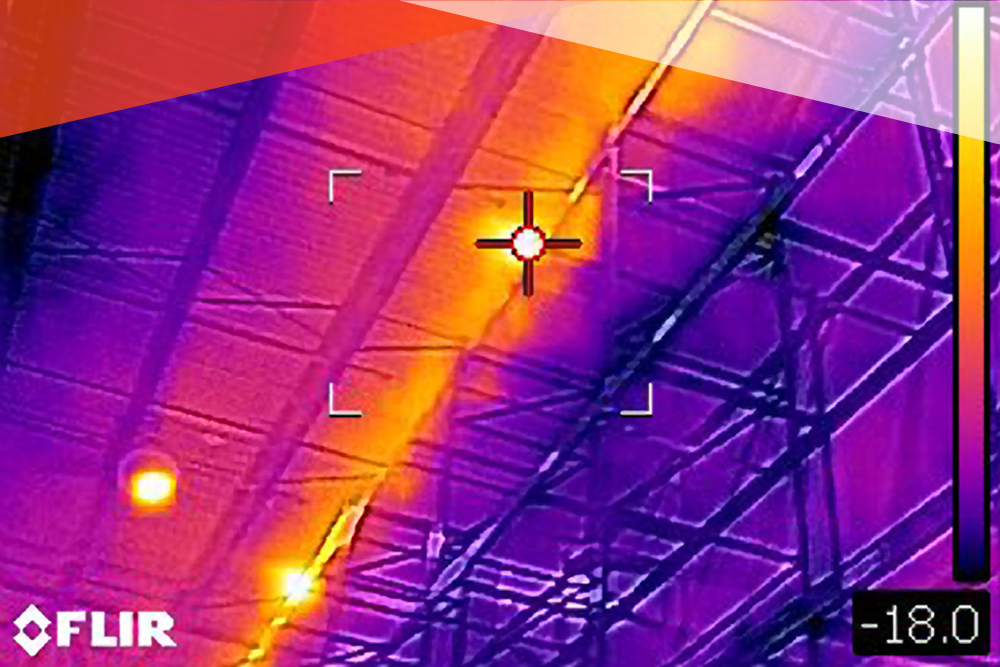By Randy Bogrand, COO
Picture this: you just stepped into your company’s freezer where the ambient temperature is negative ten degrees Fahrenheit. You brace yourself against the freezing cold and watch as your breath turns to ice in the air. Hopefully, you brought your heavy coat, or this will be a short visit. At first, you see nothing out of the ordinary. But then, for the first time in a while, you look up to see what appears to be the continent of Antarctica forming on the ceiling. A pit begins growing in the part of your stomach where your lunch should be as the scope of your newfound problem becomes evident.
The idea of ice appearing in an ultra-cold environment seems normal enough to the untrained eye. However, if you are responsible for any of the 3.7 billion cubic feet of gross refrigerated storage capacity in the United States, you know better. Visible ice is a clear sign that something is wrong with a cold storage facility’s thermal environment. If you can see the ice, it has probably invaded your roofing’s insulation, robbing it of its R-value and sapping excess energy from every operating hour. Ice also starts with condensation, which puts food at greater risk of contamination and your facility in the crosshairs of one of this country’s many regulating bodies.
Unfortunately, most experts understand that eliminating ice is no easy fete. Roof systems are great for keeping water out of a building, but they cannot stop air. And regardless of what the factory rep tells you, no amount of spray foam will seal up your building’s vapor barrier. With so much on the line, inaction is not an option. So, what is a cold storage facility operator to do?
Quick! Call Vapor Armour!
Vapor Armour has been on the frontlines in the battle against ice for over 20 years. In the early days, we faced off against the entrenched attitude of cold-storage operators who would tell us, “There’s always been ice in my building, and it hasn’t been a problem,“ which is a lot like saying, “My artery has always been bleeding, but I’m not dead yet.”
That old approach led to a lot of problems. While many of them — like increased operating costs and building wear and tear — remained invisible to the public, a few widespread listeria outbreaks brought greater attention to the role ice and condensation play in food safety. Over the years, our ongoing educational efforts and increased regulatory pressure through the Food Safety Modernization Act have helped change the conversation. As a result, cold storage operators no longer see ice as a cost of doing business. Instead, it is a business problem in need of a solution.
So today, when cold storage operators look up and discover ice on their ceiling or suspect their thermal environment is compromised, their first call is often to Vapor Armour
Stopping Ice and Condensation: as Easy as 1, 2, 3.
Ice is a stubborn foe, but that does not mean it is invincible. Vapor Armour’s approach, developed over years of successfully battling these frozen beasts, originates from our forensic evaluation process. Once a cold-storage operator calls us for help, our experts spring into action and visit the facility, where we measure the building’s overall health. After identifying the full scope of ice infiltration and tracing its course through a building, we can create a plan to seal the envelope and stop ice formation once and for all. However, before we even set foot on a roof, we make sure our customers understand what causes ice to form in cold storage facilities in the first place.
1: Understand Vapor Drive
A typical cold storage facility contains several different thermal environments. An air-conditioned office area sits at a comfortable 72 degrees. Those offices might share a wall with refrigerated space cooled to 40 degrees or less. Next to refrigerated storage could be the freezer area, with temperatures at a frigid negative 10 degrees. Then, there is the outside air, which can often be very warm and very humid.
Vapor drive occurs when warmer, wetter air from the office, or the refrigerator, or from outside the building naturally moves to replace colder air in the freezer and cooler. When those two air masses collide, ice and condensation start to form. The trick to eliminating ice and condensation is to track vapor drive to its source and stop the warm air intrusion. That is where our forensic evaluation process comes into play.
2: Uncover the Source of Air Infiltration
A Vapor Armour forensic evaluation is a comprehensive examination of a cold storage facility’s thermal environment. Our vapor drive experts are like old west trackers, expertly attuned to the cold-storage environment, scouting for the most subtle signs only they can see. At the end of the evaluation, we provide a detailed report about the extent of ice intrusion, how air and moisture move through the building, and offer potential solutions for those problems. Here is how a typical forensic evaluation unfolds:
Initial Site Assessment
The process starts with an on-site examination where Vapor Armour employees visually inspect the facility for obvious signs of condensation and ice formation. We also rely on anecdotal evidence from the facility’s maintenance staff about their experience with these issues.
Thermal Imaging
Next, our team uses thermal imaging technology to examine the conjunction of the building’s wall and roof deck. Thermal imaging enables us to peer through solid surfaces and track how warm air moves through a building. Areas with significant temperature variations show up as white hot on our infrared cameras and indicate spots where ice and condensation might exist.
Core Sampling
The results of our thermal imaging lead us to the roof. We begin with a visual inspection to see if there is a noticeable difference between the middle and edge of the roof. For example, sometimes, there is so much ice buildup that the roof crunches beneath our feet. Then, we cut two-inch core samples from the roof deck. If the insulation in those samples contains ice or moisture, we know the building has major problems with its thermal envelope. Our team can often track the movement of air within a building by cutting core samples from different spots across a roof.
Findings Report
We compile our findings from the forensic evaluation into a detailed report that includes the conditions present when we made the analysis, our step-by-step evaluation process, the diagnostic results, and recommendations for addressing any identified issues.
Step 3: Seal Your Building’s Thermal Envelope
The forensic evaluation process typically uncovers the sources of the vapor drive, if any. In those instances, we provide our customers with a plan for installing Vapor Armour and replacing compromised insulation. These fixes will seal the building’s envelope, mitigate further damage, and prevent future ice and condensation building. However, in some cases, ice buildup has caused considerable damage to the roof and walls that we cannot fix. We will then offer a referral for our trusted construction vendors, who can walk building owners through the repair process.
“Why Would We Pay You to Cut Holes in Our Roof?”
This is a great question. Here is our answer: you do not pay us. We perform our forensic analysis for free. Why? Because providing this service at no cost enables us to give an unbiased opinion on your building’s health. If you are concerned about voiding your roof’s warranty, we can coordinate with your local roof warranty representative to patch our cores as we work.
A Vapor Armour forensic evaluation is about more than just evaluating vapor drive. It is also a free risk assessment of your building’s overall health. So perhaps the better question is, “How and when can I schedule my forensic evaluation?” The how is: contact us (by calling, by email, or through our website). The when should be now!


